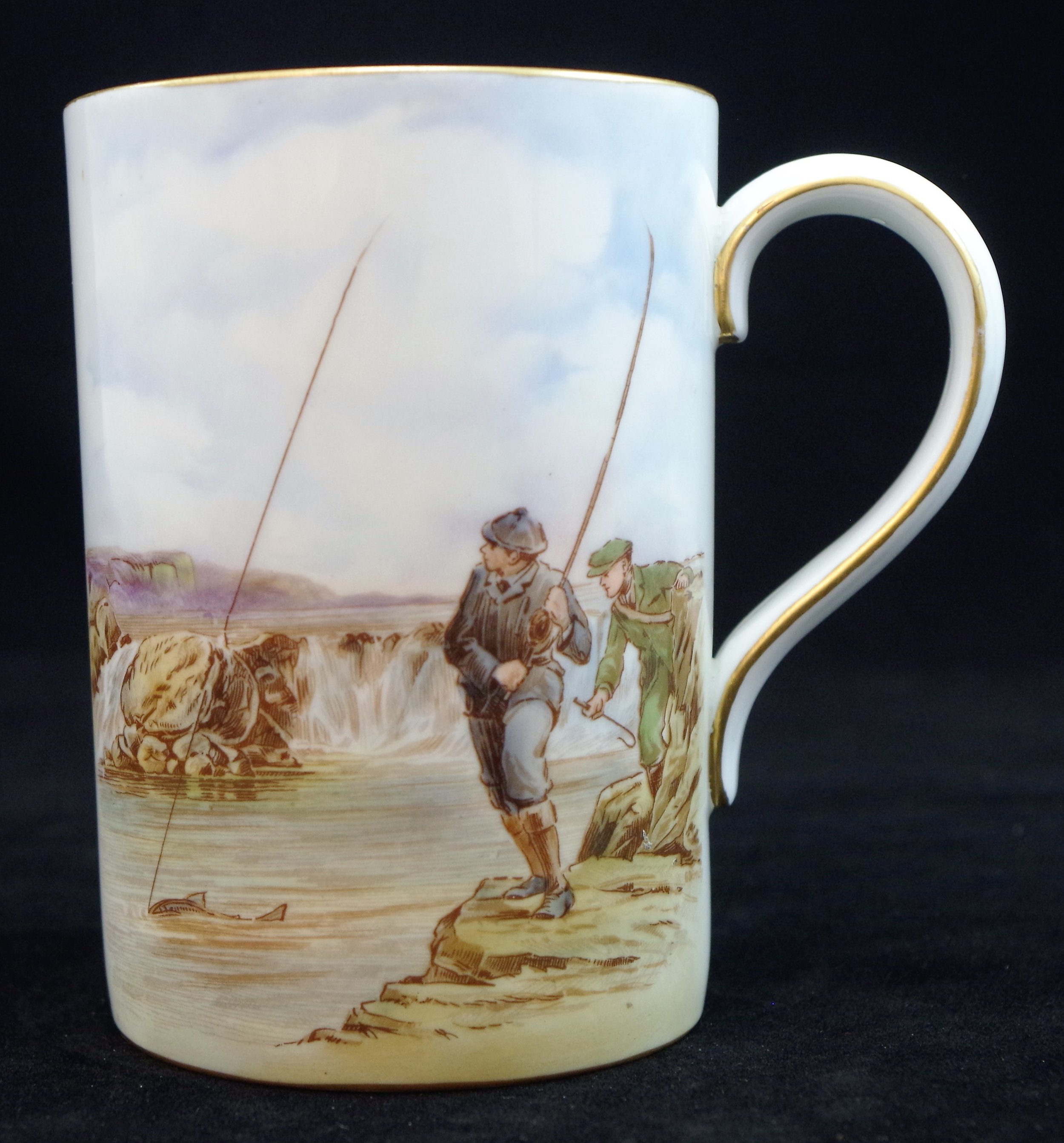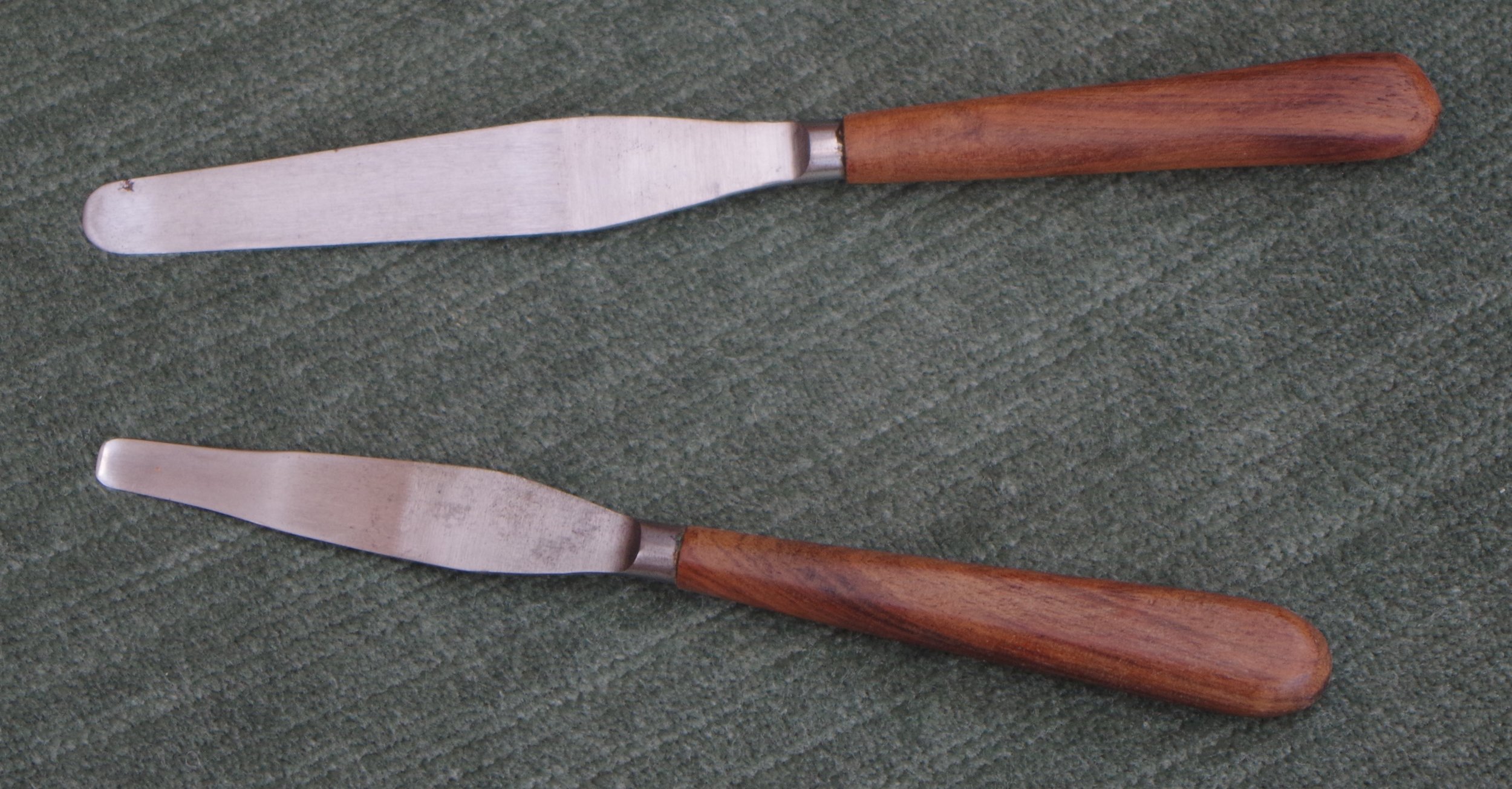When Pip Bentley aged 14, took her first bus journey to Osmaston Road from the village of Melbourne in December 1946, little did she know that this was to be the start of a forty year career at Royal Crown Derby. Despite her aspirations to do secretarial work (she had managed to secure an offer of a job through school but it didn't start for two more months) her father, aware of the job difficulties at the time and anxious for her to find paid employment quickly, insisted that she should apply to Royal Crown Derby as an apprentice gilder. Following a successful interview she began work at the factory on the 2nd January 1947. She recalls her apprehension at arriving in Derby which to her was "a very big and frightening city", rather different from life in Melbourne. In the event Pip was placed in the enamellers department where Joan Midgley was in charge of training the apprentices.
This image shows Joan Midgley training the apprentice enamellers and was probably taken in about 1948. Pip is the furthest away of the two girls in the bottom right corner of the photograph. In an article in the Derby Telegraph of Monday 4 February 2013 Pip explains that "Although I wasn't particularly artistic, I was very precise and had an eye for detail". She didn't like the job at first because she "would come home covered in red paint (and smelling of turpentine). Once I got used to it I loved it. Some of the pieces had paint outlines which we filled in. We started in what was quite a small room with about 20 women. A few years later we moved into a really big room which had the enamellers and gilders working together."
Pip completed the training period painting with red enamel and then progressed to painting the roses on the Posie pattern. Her hours were 8am to 6pm Monday to Friday and 8am to 12.30pm Saturday. This meant catching a bus to work at 7.05am and then the bus home at 6.10pm - a long day for someone just out of school. In her account of her career in Royal Crown Derby (John Twitchett and Betty Bailey revised edition 1988) Pip recalls that "about 10am somewhat dubious beverages arrived in the work-room and were usually drunk through thirst rather than for pleasure. The mid-day break was mainly to eat our own sandwiches bought from home, although there was a contraption which would bake potatoes, and a small room served in place of a canteen."
Life was not all work and no play. As a dare aged just 15 and when Tom Allman was works manager she was encouraged to walk down the main works corridor with a lit candle singing Jesus Bids Us Shine! In the early years she looked forward to going to the Plaza ballroom on Saturday afternoons for dances. Pip recalls that prior to the works dance the girls "would sit with our hair in curlers, but our heads covered with scarves - a factory rule. These occasions were looked forward to and were held at the Midland Institute. Bus loads of soldiers would be invited to our function and usually we would be invited back to theirs. The Second World War provided no shortage of soldiers and a good deal of fun was had by all."
Above is a typical announcement; it appeared in the Derby Evening Telegraph editions of Saturday 2nd and Monday 4th October 1948. Items of china were generally given as prizes and were very much sought after because of the trade restrictions which continued in the home market until 1952. Entertainment at some of the other events was provided by Freddy Sharratt & His Band - see Telegraph image at https://bygonesderby.files.wordpress.com/2011/09/210911freddysp.jpg
At the Christmas party of Christmas Eve 1947 the Telegraph reported that "Midnight carol singing by the male voice choir of the Royal Crown Derby Porcelain Co Ltd" was a feature of the entertainment! Phillip Robinson or Fred Finney appear to have been given the task of Master of Ceremonies.
Linking arms at a Royal Crown Derby dance. From left Fred Bentley, Pip Bentley, Bill Corfield, Unknown, Cyril Thompson, Maurice Parnham, Unknown, Unknown.
Pip recalls that "as young girls our wages were not high, but we would save up and buy a brooch and earrings set of pastel colour and with our professional sense of colour and our painting talents we would cold-colour paint these sets each time a new colour was required to complement a new dress or outfit."
To alleviate some of the monotony of the work the girls would create their own entertainment. "We had a girl who sang solos and she would also entertain the gilders. Poems and descriptions of the latest film at the local cinema were given, this being the age of the Hollywood film star with all the glamour and escape it created." As some of the work was piecework - i.e. based on the number of roses painted, the other girls would make sure that the performers' work was kept up to prevent losses in wages.
With none of the modern conveniences of air conditioning and a proper heating system, an uncomfortable working environment could be a particular issue. "Summer could bring its problems, but here again the practical Midland girls made large paper hats from the waste from the lithographers department and subsequently we looked more like nuns. The added heat came from the glass roof and windows as light is essential to decorating. To cool our feet we filled large tureens with cold water and then we had foot-baths! When winter came we had hot plates from the kiln discretely placed in our jumpers."
Factory visits, especially by celebrities, also provided some light relief and excitement. On the occasion of the visit of Princess Elizabeth in 1949 Pip was sent home to Melbourne by her Supervisor Joan Midgley to fetch roses from her garden to decorate the tables. Works visitors were often known to pick up items still wet and unfired which did result in a need for a fair amount of restorative work after they had departed!
Pip demonstrating her skills during a factory visit. Director Colin Osborne is on the left.
At the time Pip started at the factory, marriage very often meant the end of that girl's employment. An impending wedding was celebrated by decorating the benches using hoops from the barrels which were originally used to pack and transport the china. She recalls that it was the "custom to raise two shillings per head and to get a half tea set in white. I still have mine."
After the departure of Decorating Manager John Price in 1949 the enamellers began to sign off work on their own account. Both of the above pieces are signed by Pip. In hunting scenes it was her usual practice to paint her name along a blade of grass. Figurines and jewelry were usually initialled "B B" in whatever colour she was using at the time. Prior to 1949 her mark had been the letter "A".
A selection of figurines all painted by Pip with an image showing her mark. A bird figurine would need about four to five hours work to enamel, with a plate and tankard each taking about three hours. Two firings were normally required in respect of the enamelling, especially if red was needed, (as was invariably the case with the hunting scene plates), as this fired at a different temperature and was liable to turn brown if fired incorrectly.
A unique hand painted plaque painted by Mr H C G Jacob and presented to Pip by him in 1957. One of two brothers, H Jacob worked at the factory 1951-59. The underglaze factory mark on the reverse dates the body of the piece between 1887-90, so it had presumably been languishing in the glost warehouse for as long as sixty years before it was actually decorated! The image was taken from a portrait of the young princess in 1933 by artist Philip de László.
Pip's talent was such that she progressed from painting roses on Posie to the flowers on the figurine bases and on the brooches and other floral pieces. She went on to paint the birds and other figurines, and in the mid to late 1950's she was appointed enamelling Supervisor. Life was not always plain sailing. She recalls that on one occasion as Supervisor she "collected biscuit blue instead of the mauve enamel used in decorating colour "Aves" (Pattern A549). The result was a complete disaster the other colours gleaming, but oh dear! the substituted mauve was more akin to cement".
Pip remembers that production did not always run as smoothly as was hoped. If the ware was not stacked correctly it could shift and jam in the kiln which had to be turned off and allowed to cool before the truck could be removed. On one occasion where a problem occurred in one of the smaller kilns she describes the resultant molten mass of plates as "like a fountain".
A pair of Pip's palette knives. The lower one is well worn though use.
A design for a teapot. Phillip Robinson would present a sketch of a design to Pip and ask her to prepare a finished version so that a litho could be produced from it. A teapot of this design was manufactured but never went into production and Pip was given the trial piece. Pip drew some of the first designs to be lithographed.
Pip continued working at the factory long after the period covered by this website. She met and talked to several members of the Royal Family as well as other important visitors including the broadcaster Richard Dimbleby, Margaret Thatcher and Lord Snowdon. She also worked on Royal commissions including a plate she decorated for the Queen Mother in 1971. She was also entrusted with the task of delivering a special order of three plates to Buckingham Palace. Pip retired after a forty year career with Royal Crown Derby in 1987.
This blog has been prepared by reference to Pip's contribution to the revised edition of Royal Crown Derby (John Twitchett and Betty Bailey 1988), to articles which appeared in the Derby Telegraph Bygones section of February 4th and 11th 2013, and an interview with Pip in March 2017.
John and Val Robinson 2018.


















